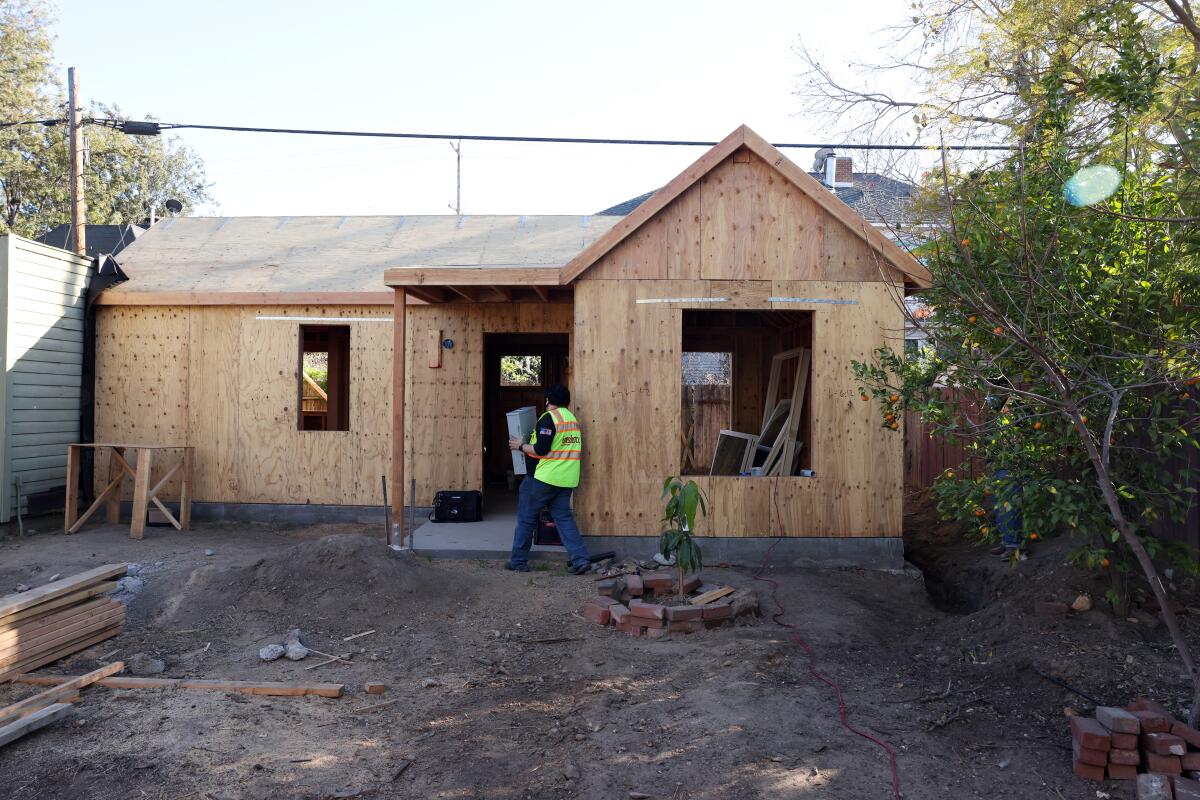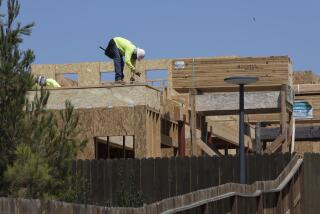Editorial: To save California, sacrifice single-family zoning

For decades now, California leaders have been stuck in a low-density, single-family, not-in-my-backyard 20th century mindset. The result is a deep housing shortage that is driving more Californians into poverty, worsening inequality and hurting economic opportunity.
The staggering cost of buying or renting a home in California takes a terrible toll. Rents have risen faster than incomes, and 1 in 3 households statewide now spend more than half their income on rent, leaving many families one rent increase or one missed paycheck away from losing their homes. When residents cannot afford to live near jobs, they often move to far-flung suburbs and commute hours each day, worsening traffic congestion and air pollution. Employers say high housing costs hurt the state’s economy by making it hard to attract and retain skilled workers — a situation that has led some companies to relocate to states where their middle-class workers can afford to buy homes.
The heart of the problem is this: California has failed to build enough housing to keep up with population growth and demand. California needs to add between 1.8 million and 2.5 million new homes by 2025 to ease the housing shortage that is driving up rents and home prices. But when more than two-thirds of residential land in California is zoned for single-family homes, it becomes difficult and expensive to add housing.
This isn’t just a California problem. Across the nation, about 75% of residential land is zoned exclusively for single-family homes. Too many communities make it too hard to build a diverse housing stock. They prioritize the construction and preservation of single-family homes, at the exclusion of apartments, condos and townhomes that would be more affordable to middle and lower-income renters and buyers. That is fueling a housing shortage; the U.S. needs 3.8 million more homes to meet the demand of household growth and to provide enough inventory that prices stabilize.
Restrictive zoning has its roots in racist public policies. Single-family zoning was often adopted over the last century as a way to segregate neighborhoods without explicitly banning any racial or religious group. Today, restrictive or exclusionary zoning perpetuates racial and economic segregation by prohibiting lower-cost apartments and townhomes in high-opportunity single-family neighborhoods with good schools, parks and other amenities. President Biden and his economic advisors have warned that restrictive zoning widens the racial wealth gap and hurts upward mobility.
In California, lawmakers have an opportunity this year to take small but vital steps toward easing the housing crisis. Senate Bills 9 and 10 would allow small multifamily buildings on single-family lots. These are the two most controversial housing bills this year. That should tell you just how politicized housing legislation has become because, despite all the angst, these bills probably won’t make a big impact on home construction any time soon.
And yet, lawmakers should still pass SB 9 and SB 10, and Gov. Gavin Newsom should still sign them. California needs to dismantle exclusionary zoning. This will have to be a bill-by-bill and city-by-city process until, finally, California communities remove the restrictions that stifle home creation and perpetuate segregation and inequality.
The more far-reaching of the two bills is Senate Bill 9 by Senate President Pro Tem Toni Atkins (D-San Diego). SB 9 would allow up to four units of housing on a single-family lot. A property owner could create a duplex. Or the owner could subdivide the property into two lots and build up to two units on each lot for a maximum of four units. The properties would generally need to comply with existing design standards.
While SB 9 may sound like a radical change, it isn’t. California has already passed laws in recent years that override single-family zoning to allow homeowners to build three units on their property. A single-family home can have a detached or attached granny flat on the lot, and a smaller junior unit attached to the main house.
SB 9 allows one more unit than existing law. It would also give property owners more options in what types of units they build and it allows them to split the lot and sell — not just rent — the new units. Those new options could entice more property owners to build additional homes on their property. But given the restrictions built into SB 9 and the market conditions, only about 1.5% of single-family homes statewide are likely to take advantage of SB9, according to a recent analysis. Again, it’s a modest but worthwhile reform.
Lawmakers have given lots of excuses to reject past zoning reform bills, and Atkins has sought to alleviate those concerns in SB 9. The bill wouldn’t apply in historic districts or in environmentally sensitive areas, like wetlands and certain high fire-risk areas. It wouldn’t apply if a house has been occupied by a renter within the last three years, a provision intended to prevent tenant displacement.
Last week Atkins revised SB 9, in another attempt to appease opponents. One amendment lets local governments stop a duplex or lot split if the project would pose an unfixable public health or safety impact. Another amendment requires that a property owner live in one of the units for three years after a lot split. That change is designed to ease fears that the bill could prompt real estate speculators and corporations to buy up single-family homes in low-income communities, fueling gentrification and displacement.
Yes, the owner-occupancy requirement will further whittle down SB 9’s ability to create more housing. But it’s a reasonable restriction if it helps quell concern in disadvantaged communities. That’s important because SB 9 is really a proof-of-concept bill. It’s about showing people that adding a little density and a few more homes won’t destroy their neighborhood.
SB 9 is also the next step in continuing to legalize a style of construction that used to be quite common, with single-family homes next to duplex, triplex and fourplex apartment buildings. That mix of housing was only later prohibited by single-family zoning.
Senate Bill 10 is an even more modest housing streamlining bill. It shouldn’t be controversial. Yet it is.
SB 10 would allow a local government to zone any parcel of land, including a single-family lot, to allow a building of 10 units or less. The property would have to be urban infill or near public transit. SB 10 would allow local governments to upzone without going through a lengthy California Environmental Quality Act review or face CEQA lawsuits, which can delay projects and make them more expensive. Local governments can also use SB 10 to override voter-imposed land-use restrictions that would block such small residential buildings.
SB 10 is not a mandate. Cities can choose to upzone properties near transit. Or not. SB 10 gives cities and counties local control and CEQA streamlining — two policies local elected officials consistently call for. Under SB 10, local governments are allowed to require affordable housing in these upzoned projects.
SB 10 is completely voluntary, which is why it’s so baffling that the Los Angeles City Council and other local governments have opposed it. If cities don’t want to streamline construction of small apartments near transit, they don’t have to. It’s optional. The vehement opposition probably has more to do with the author, Sen. Scott Wiener (D-San Francisco), than the bill itself. Wiener has been the champion of zoning reform for the last three years and thus has become the favorite target of NIMBY groups. But in their haste to demonize density and state housing production bills, L.A. and other cities could be denying themselves a useful tool.
Ending single-family zoning is not the silver bullet to end California’s housing crisis. But it is an important piece of a larger effort in the state — and the nation — to fix failed policies and misplaced priorities that have led to a broken housing market and woefully inadequate housing safety net. There’s a lot of work to be done. SB 9 and SB 10 can help.
More to Read
A cure for the common opinion
Get thought-provoking perspectives with our weekly newsletter.
You may occasionally receive promotional content from the Los Angeles Times.






